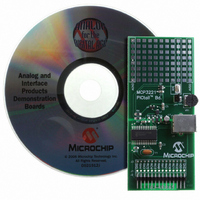MCP3221DM-PCTL Microchip Technology, MCP3221DM-PCTL Datasheet - Page 15

MCP3221DM-PCTL
Manufacturer Part Number
MCP3221DM-PCTL
Description
BOARD DEMO FOR PICTAIL MCP3221
Manufacturer
Microchip Technology
Series
PICtail™r
Type
A/Dr
Datasheets
1.MCP3221A5T-IOT.pdf
(28 pages)
2.MCP3221DM-PCTL.pdf
(20 pages)
3.MCP3221DM-PCTL.pdf
(20 pages)
Specifications of MCP3221DM-PCTL
Number Of Adc's
1
Number Of Bits
12
Sampling Rate (per Second)
22.3k
Data Interface
Serial
Inputs Per Adc
1 Single Ended
Voltage Supply Source
Single Supply
Operating Temperature
-40°C ~ 85°C
Utilized Ic / Part
MCP3221
Product
Data Conversion Development Tools
Resolution
12 bit
Interface Type
USB
Silicon Manufacturer
Microchip
Silicon Core Number
MCP3221
Kit Application Type
Data Converter
Application Sub Type
ADC
Silicon Family Name
PICtail
Kit Contents
Board Cables CD Docs
Rohs Compliant
Yes
For Use With/related Products
MCP3221
Lead Free Status / RoHS Status
Contains lead / RoHS non-compliant
Lead Free Status / RoHS Status
Lead free / RoHS Compliant, Contains lead / RoHS non-compliant
Available stocks
Company
Part Number
Manufacturer
Quantity
Price
Company:
Part Number:
MCP3221DM-PCTL
Manufacturer:
MICROCHIP
Quantity:
12 000
5.0
5.1
The following bus protocol has been defined:
• Data transfer may be initiated only when the bus
• During data transfer, the data line must remain
Accordingly, the following bus conditions have been
defined (refer to Figure 5-1).
5.1.1
Both data and clock lines remain high.
5.1.2
A high-to-low transition of the SDA line while the clock
(SCL) is high determines a START condition. All
commands must be preceded by a START condition.
5.1.3
A low-to-high transition of the SDA line while the clock
(SCL) is high determines a STOP condition. All
operations must be ended with a STOP condition.
5.1.4
The state of the data line represents valid data when,
after a START condition, the data line is stable for the
duration of the clock signal’s high period.
The data on the line must be changed during the low
period of the clock signal. There is one clock pulse per
bit of data.
FIGURE 5-1:
© 2006 Microchip Technology Inc.
SDA
SCL
is not busy.
stable whenever the clock line is high. Changes in
the data line while the clock line is high will be
interpreted as a START or STOP condition.
(A)
SERIAL COMMUNICATIONS
I
2
C Bus Characteristics
BUS NOT BUSY (A)
START DATA TRANSFER (B)
STOP DATA TRANSFER (C)
DATA VALID (D)
CONDITION
START
(B)
Data Transfer Sequence on the Serial Bus.
ACKNOWLEDGE
ADDRESS OR
VALID
(D)
TO CHANGE
ALLOWED
DATA
Each data transfer is initiated with a START condition
and terminated with a STOP condition. The number of
data bytes transferred between the START and STOP
conditions is determined by the master device and is
unlimited.
5.1.5
Each receiving device, when addressed, is obliged to
generate an acknowledge bit after the reception of
each byte. The master device must generate an extra
clock pulse which is associated with this acknowledge
bit.
The device that acknowledges has to pull down the
SDA line during the acknowledge clock pulse in such a
way that the SDA line is stable-low during the high
period of the acknowledge-related clock pulse. Setup
and hold times must be taken into account. During
reads, a master device must signal an end of data to
the slave by not generating an acknowledge bit on the
last byte that has been clocked out of the slave (NAK).
In this case, the slave (MCP3221) will release the bus
to allow the master device to generate the STOP
condition.
The MCP3221 supports a bidirectional, 2-wire bus and
data transmission protocol. The device that sends data
onto the bus is the transmitter and the device receiving
data is the receiver. The bus has to be controlled by a
master device which generates the serial clock (SCL),
controls the bus access and generates the START and
STOP conditions, while the MCP3221 works as a slave
device. Both master and slave devices can operate as
either transmitter or receiver, but the master device
determines which mode is activated.
ACKNOWLEDGE
(D)
MCP3221
DS21732C-page 15
CONDITION
STOP
(C)
(A)












